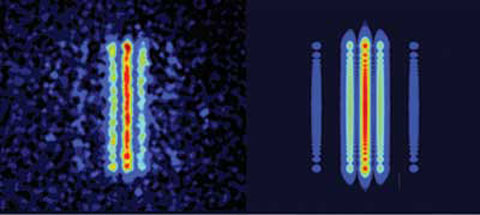Double Slit X-Rays

An experimental (left) and theoretical (right) interference pattern for x-rays traveling through a double slit experiment. Image originally published in October, 2010.
Image Credit: JILA/M.-C.Chen et al./PRL
January 2, 2014
Thomas Young's famous double-slit experiment from the early 1800's pioneered the belief that light behaves as a wave (and, eventually, influenced the acceptance of wave-particle duality). In the experiment, light was shown on a material with two equally-wide slits that allow light to pass through. Beyond this material was a screen for projecting the interference pattern arising from the light's passing through the slits.
Young's experiment showed that the two slits created an interference pattern with peaks and valleys, similar to the two images seen above, demonstrating light's wave-like behavior. These newer images, however, arose from an experiment (on the left) and computer simulation (on the right) with x-rays instead of visible light.
M.-C.Chen and his collaborators on this work used the double-slit experiment to verify their beam's coherence. For more information about this research, check out the team's paper.














